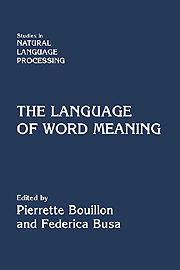Book contents
- Frontmatter
- Contents
- List of Contributors
- Preface
- Introduction: Word Meaning and Creativity
- Part I Linguistic Creativity and the Lexicon
- Part II The Syntax of Word Meaning
- Part III Interfacing the Lexicon
- 13 Introduction
- 14 Metaphor, Creative Understanding, and the Generative Lexicon
- 15 Metaphor in Discourse
- 16 Syntax and Metonymy
- 17 Generative Lexicon Meets Corpus Data: The Case of Nonstandard Word Uses
- Part IV Building Resources
- Index
14 - Metaphor, Creative Understanding, and the Generative Lexicon
Published online by Cambridge University Press: 07 October 2011
- Frontmatter
- Contents
- List of Contributors
- Preface
- Introduction: Word Meaning and Creativity
- Part I Linguistic Creativity and the Lexicon
- Part II The Syntax of Word Meaning
- Part III Interfacing the Lexicon
- 13 Introduction
- 14 Metaphor, Creative Understanding, and the Generative Lexicon
- 15 Metaphor in Discourse
- 16 Syntax and Metonymy
- 17 Generative Lexicon Meets Corpus Data: The Case of Nonstandard Word Uses
- Part IV Building Resources
- Index
Summary
Introduction
Metaphor, and the distinction between the figurative and the literal uses of language, have puzzled philosophers and linguists at least since Aristotle. The puzzle can be stated in the following, rough, form: How can words in certain configurations mean something different from what they mean in their literal use, prescribed by the rules of the language, and at the same time convey significant insights into what we, in a given context, take as parts of reality? In order to appreciate the force of the question we must separate the metaphorical meanings from the new literal meanings that an individual, or a group, might introduce into a language, such as parenting, or critiquing. Such innovations are extensions of literal language, not metaphors. Metaphors rest on rules of language, but also violate them. They do not describe reality directly. Thus, the true/false dichotomy does not apply to them without qualifications. An adequate theory of metaphor should explain this unique position of metaphoric meaning. To expand on this a little, this essay proposes that a theory of metaphoric meaning should account for the following list of facts or intuitions.
(i) Metaphors give us new meanings and a deepened understanding of the objects of our descriptions or reasoning.
(ii) Metaphors can have aesthetic value.
(iii) At some stage, a subjective element enters into the interpretation of metaphors. This element is creative insofar as it goes beyond what is given by the rules of language but it presupposes and rests on such rules.
[…]
- Type
- Chapter
- Information
- The Language of Word Meaning , pp. 247 - 261Publisher: Cambridge University PressPrint publication year: 2001
- 4
- Cited by



